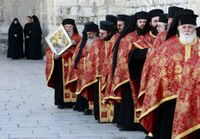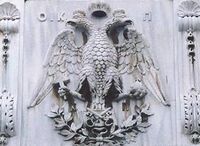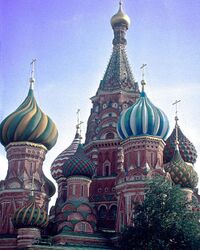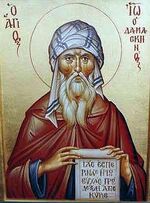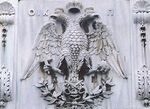Eastern Orthodox
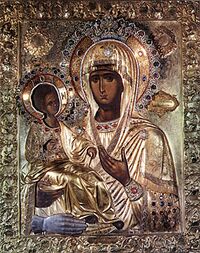
The Eastern "Orthodox" Church are best described as Roman Catholics without a pope, or, more correctly, Roman Catholicism is Eastern "Orthodoxy" plus papal absolutism and other late medieval heresies (e.g., the filioque, Immaculate Conception, etc.). The name "Orthodox" was made up, and it is to be put in quotes in order to demonstrate that this is a "false" religion that does not, alas, adhere to tradition as such. The religion is known to be one of the rare few that actually lie about their own beliefs. The most well-known religious misinformation they profess is their claim to monotheism. The reality is that they worship a broad spectrum of objects that range from icons -- or, in Greek, eikon -- (cf. idols) to saints to onions. The date when Eastern Orthodoxy replaced Christianity as the state religion of the Byzantine Empire is disputed, but many believe it was in 843 when icon "worship" was legalized and deemed true to Orthodox Tradition by the Seventh Ecumenical Council.
Famous Orthodox Art[edit]
The picture to the right is a famous Orthodox symbol that only a selected few can interpret -- namely those who are already experience a state of Divine ekstasis. To the Orthodox however, it has only been deemed famous by me. Very few actually know what I intended when I was making this, but luckily, Uncyclopedia knows! One day I was playing a new game I got on my PC called regedit. When I restarted restarted PC, I saw this, and immediately knew it was a sign from the supra-essential Godhead (Glory be to thee, O God). To this day, this mysterious sign continues to show up on people's PCs, but few actually know what it is. The sign means that your PC will undergo a great and cool change. No really, it actually does, isn't that scary?
The Orthodox are also known for raising dogs in Upstate New York, kittehs, making cheesecake, and running around in funny looking cassocks.
What do they worship?[edit]
Some call them "icon worshipers," but why would anyone worship something on your desktop? A "real" Orthodox, however, will claim that these objects are "venerated" and not "worshipped," as worship is directed to God alone; however, we iconoclasts know this certainly is not the case. While the Orthodox are known for highly-ritualized religious artwork, they also worship onions. As a result, they also worship desks, computers, cats (cf. Timothy the Cat -- one of their utterly bizarre saints), dogs, and YOU! That's right, you are a false deity that is currently being worshiped! That means we know where you are going when you die*!
In contrast to the other oriental churches, Eastern Orthodox recognizes the first seven Crisis in Infinite Jerusalems and maintains a cascade of abusive short term relationships with eastern European and Middle eastern dictatorships.
Idolostasis[edit]
If you go into an "Orthodox" Church you will see a large wall (in Russian Churches, it usually touches the ceiling) covered in icons of saints, Jesus Christ, his mommy, etc. This is called the idolostasis (or, as the "Orthodox" say, iconostasis), which means "magical idol wall" in Russian, Greek, Arabic, Aramaic, Greeklish, Latvian, or one of those other crazy east European languages. Nobody knows what goes on behind it; many believe that secret experiments controlled by the government occur, including but not limited to alien autopsies. There is a chance Jesus could be hiding there in the Tabernacle, but the Orthodox priests and babushkas will taken you down if you try to sneak past it, so no one knows for certain. For the Ethiopian "Orthodox," the idolostasis hides the Ark of the Covenant (i.e., the crazy box-thing that killed gentiles and shit). The idolostasis is "worshipped" (Babushkah: "NYET, VENERATED!") and is one of the central elements in the Orthodox liturgy.
Onionism[edit]
Most "Orthodox" Christians claim to be monotheists, then quickly change the subject to either parish politics, whether Fr. So-and-so can sing proper Byzantine chant, or who will conduct the next coffee hour. What they do not want you to know is that they really worship the goddess Onion. The "Orthodox" believe that the goddess Onion is the Supreme Being (i.e., the Hyperessential, Consubstantial, and Supraexistant Being who was, is, and ever shall be unto ages of ages), thus meaning that all other onions are simply an "image" of their Creator. Therefore, they worship onions (i.e., the vegetable) along with the respective goddess. Despite the onion's status in the Church, most of the ethnic groups associated with "Orthodoxy" commonly use onions in the preparation of various delicious dishes; while this could be viewed as sacrilegious, remember that the Orthodox also partake of the literal flesh and blood of Christ each liturgy like the Papists (AKA Roman Catholics, or, in the words of the Orthodox: Schismatic Violent Filioquists Who We Periodically Talk To).
The Orthodox claim that the liturgy is their main method of worship, but as declared in the Council of Holy Malakas in 1096, the liturgy is simply a means to distract the heretics from the fact that we — erm, I mean, "they" — actually worship the Holy Goddess Onion.
The Onion goddess was actually the Patriarch of Constantinople. One day He (the Onion goddess was originally a man) started a religion known as Neo-Onionism (which currently has its own news network), and mixed it with Christianity. At first, the Papists viewed it as neo-Gnosticism, but they quickly tried to usurp the official Church of Constantinople to their vile papist ways. The Orthodox, of course, resisted. The result was Eastern Orthodoxy. So how did the Patriarch become a Goddess? Well, in the 666th (or 616th, depending on whether you are a Latin or Greek) Ecumenical Council -- which occurred in Nicaeoephasiopopodopolisgrad -- they decided that they would make the Patriarch the Goddess of all onions:
| “ | Some Ecumenical Council has ruled that the Patriarch of Constantinople who revealed to us the truth of Neo-Onionism, was in fact the Onion goddess herself in disguise. We have all come to this conclusion due to the fact onions are awesome. | ” |
—Canon No. 0xFF343 | ||
In current practice, the Russian Orthodox lead the other Orthodox in worship of onions. The Greeks worship baklava.
Iconoclasm[edit]
One day, Byzantine Emperor Leo III and his son, Emperor Constantine V, decided to follow the example of the ancient Israelite kings Hezekiah and Josiah and be total philistines. Leo painted over all the unholy graffiti. This became known as 'iconoclasm.' It had a good run from 726 to 787. Eventually, the church walls were religiously re-tagged again by the Blessed & Most Holy Empress Irene after the Second Council of Nicaea. (Their first one had been Standing Room Only in 325.)
Irene may have restored icons, but she was also a gangster, famous for corrupting, overthrowing, blinding, and killing her son emperor Constantine VI, in addition to digging up and desecrating the corpse of her own father-in-law and secretly transferring the office of emperor to the barbarian chieftain, Charlemagne of the Frogs and Krauts.
The Great Schism[edit]
In the year 1054 AD, the Pope of Rome (Leo IX, may he forever be a kakos malakas) got really peeved at the Pope of Constantinople (i.e., Michael Cerularius — may his memory be eternal) when he didn't recognize him as the leader of the papal rangers. Leo IX, that rat-fink bastard, decided to send one of his cardinals, Humbertus Humbert — who conveniently spoke no Greek — to make the Greek "Pope" feel his wrath ex cathedra.
When Leo's cardinal babbled at the Greek Pope Patriarch Michael Cerukarius in his Martian Dialect (Latin — the language of heretics), the Greek Pope fled back to his baklava and ouzo. This, of course, infuriated the cardinal. So one Sunday in Saint Sophia's Cathedral during a praise and worship service, the heretical Humbert and his candle-holder, Lolita, burst in and marched right up to the altar and declared Michael Cerularius' excommunication from the Latin Church. Angry and confused, Cerularius crawled into a corner, and cried in front of his favorite icon of St. Basil. Humbert ran off back to Rome before anyone could get him; after church, the Greek pope excommunicated the Roman pope and everyone in Constantinople rioted. The pope quarantined them like a zombie virus and sent in Crusaders.
The Crusades[edit]
No one cares about the first three crusades. The Fourth Crusade is when Pope Innocent III was already mad at the Greek Pope because of the the Great Schism (another word for beard envy). He was also jealous because the Byzantine Empire wasn't going through Dark Ages, but the West was. So the pope built a huge space army of space marines in power armour, and sent them right to sack Constantinople's skyhook in 1204. The Romans were eventually repelled and eventually reunion between the two occurred from 1439-53 before Constantinople fell to the Ottoman Empire. Greece was invaded by Muslims from the 14th-16th centuries and the Balkans in the 15th-16th, but luckily Greek Orthodoxy had been invading the slavs since the 9th century, so they were ready to birth a new church capitol in Moscow, the third Rome.
Orthodox Russia[edit]
Since Russia was too awesome to be conquered by Latins and Turks (and Nazis, and French, and Polish), the Russian Orthodox church remained independent until the czar took control of church appointments in 1666. Patriarch Nikon could not tolerate any discrepancy between Russian and Greek Orthodoxy. The Old Believers hung on to the older Russian practice of using the thumb together with the ring and pinky fingers while the Greco heretics used the thumb and first two finger. The two factions flashed their hand signs until finally it turned into an all out gang war. Afterwards, the czars helped them build many temples to the Onion goddess, until in came Lenin who hated Onions. Than Ronald Reagan burst through the Berlin Wall with McDonalds and made it safe for Onions again.
Hierarchy[edit]
- Patriarchs: In 451 their were originally five boroughs: Rome, Constantinople, Alexandria, Antioch, and Jerusalem.
- Metropolitans: They rule over a specific areas and not others (i.e. rural backwaters).
- Bishops: These guys are in charge of rural backwaters.
- Priests: Everyone already knows man. Allowed to have families but must give them up when taking Holy Last Orders.
- Deacons: Bright glowing things. Can be seen in the dark.
- Subdeacons: Ever so slightly smaller bright glowing things. Can't be seen in the dark
Orthodox Music[edit]
Most Orthodox music is modern and contemporary. Here are some famous Orthodox rock styles:
- Byzantine Chant- Byzantine is a late 20th century post-modern type of music, usually accompanied by an electric guitar and drums. It requires a band. It's primary influence came out of the Ottoman Empire.
- Gregorian Chant - A 21st century New-Age chant.
- Znamenny Chant: A chant composed by the elite Orthodox and generally disliked by the working class. The elitist characteristic of the chant is that few peasants can spell or pronounce it. It requires the aristocracy to correctly pronounce and spell it. The primary advantage of this chant is that it is transcribed in Znamenny Notation, or Slavic pneumes, in contrast to the modernist Satanic Western musical transcription methods. The chant originates from medieval Holy Russia.
- Valaam Chant: Some chant that came out of Russia. Too many vowels, but ironically Russian.
- Kieven Chant::Can you guess where this originated? This chant is usually accompanied by an electric keyboard.
- Russian Polyphony: Evil Latin Catholic stuff.
- Serbian Chant: Weirdly enough, this almost always in either Greek or Russian.
- I Forgot The Words And Am Making It Up As I Go Along Chant: The most common of all, and actually sounds the best comparatively. This form of chant was later adopted by Neolithic Politicians.
Differences between the Roman Catholic and Eastern Orthodox Churches[edit]
Some people believe that the Roman Catholic and Eastern Orthodox Churches are essentially the same in doctrine. This is complete bullshit. The vast difference include:
- Roman Catholics worship 3 dimensional statues, even though it was forbidden before due to all the pagan statues lying around Rome. Eastern Orthodox worship 2 dimensional images painted on wooden panels instead, except for the Onion Goddess who appears in 3 dimensions atop buildings.
- Roman Catholic religious art is generally stuck in a 17th century style, while Eastern Orthodox art is universally stuck in a 9th century style (i.e., with the exception of large portions of Russia after Peter the "not-so" Great).
- Roman Catholics use only unleavened bread for the mass in which they
eatreceive Jesus (azymes) while Eastern Orthodox use only leavened bread toeatreceive Jesus (prozymes). Let those who use unleavened bread be anathema.
- Roman Catholics believe in Purgatory, while the Eastern Orthodox believe in Tollhouses. Long story; read Fr. Seraphim Rose. It's metal.
- The Roman Catholic Church is semi-Pelagian and legalistic who claims that the Orthodox are even more semi-Pelagian for not accepting all of Augustine's rebuttals against the Pelagians under the guise of claiming he took these issues "too far."
- Roman Catholics teach a semi-Arian doctrine known as the filioque that was invented (i.e., stating in the Nicaean Creed: "...the Holy Spirit, the Lord, the Giver of Life, who proceeds from the Father and <<the Son>>"). Let those who proclaim this be anathema.
- Roman Catholics had a very clever idea of charging people for sin. Eastern Orthodox deemed this immoral and instead taxed sin. Both ideas failed with the advent of the curtain.
- Eastern Orthodox worship onions; Catholics worship the Pope (let him be anathema).
- Eastern Orthodox have beards bigger than any other denomination.
- Eastern Orthodox saints Cyril and Methodius were allowed to translate the bible into Slavic, unlike William Tyndale who was burned by the Roman Catholic church for translating it into English.

